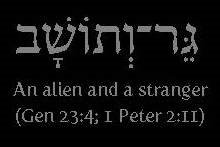(This is the second in a series of Israel tour posts; the first is here.)
 Our first stop on our first day of touring was Caesarea, well-known as the city Herod the Great transformed from the fishing village of Strato's Tower into a major port. It is also the city where, according to Acts 10-11, Peter encountered the Gentile centurion Cornelius, and where Cornelius and his invited guests encountered the Holy Spirit. The group is standing on the stage of a much-restored Herodian theatre:
Our first stop on our first day of touring was Caesarea, well-known as the city Herod the Great transformed from the fishing village of Strato's Tower into a major port. It is also the city where, according to Acts 10-11, Peter encountered the Gentile centurion Cornelius, and where Cornelius and his invited guests encountered the Holy Spirit. The group is standing on the stage of a much-restored Herodian theatre: Looking north from the theatre compound, there is a nice overview of the ancient city. Off to the left of the next picture is the ruins of the "Palace of the Procurators"; the stepped seats on the right overlook a Herodian amphitheatre, large enough for chariot races. In the distance are the walls of the crusader city and, on the left, the remains of the ancient city's man-made harbour:
Looking north from the theatre compound, there is a nice overview of the ancient city. Off to the left of the next picture is the ruins of the "Palace of the Procurators"; the stepped seats on the right overlook a Herodian amphitheatre, large enough for chariot races. In the distance are the walls of the crusader city and, on the left, the remains of the ancient city's man-made harbour:
After Herod's son Archelaus was deposed in AD 6, Judaea was ruled directly by Roman prefects and procurators, who made their capital in Caesarea, and their headquarters, apparently, in this palace:
 Jerome Murphy-O'Connor (243) speculates that it was here that the apostle Paul was imprisoned for two years (see Acts 23-26). Not a bad view for a prison!
Jerome Murphy-O'Connor (243) speculates that it was here that the apostle Paul was imprisoned for two years (see Acts 23-26). Not a bad view for a prison!On the northeastern end of the amphitheatre . . .
 . . . "are four long vaulted warehouses of the C3 AD"(O'Connor 245), one of which was transformed into Israel's only Mithareum, a place of worship for devotees of the god Mithras:
. . . "are four long vaulted warehouses of the C3 AD"(O'Connor 245), one of which was transformed into Israel's only Mithareum, a place of worship for devotees of the god Mithras: The worship of Mithras was a mystery religion popular among the Roman army. Apparently important to the construction of this Mithraeum was a hole in the roof through which a ray of sunlight would strike the altar at noon on the summer solstice (June 21):
The worship of Mithras was a mystery religion popular among the Roman army. Apparently important to the construction of this Mithraeum was a hole in the roof through which a ray of sunlight would strike the altar at noon on the summer solstice (June 21):
East of the amphitheatre and parallel with it is the Byzantine Cardo, or main street. According to O'Connor, "it is extremely probable that the Herodian Cardo followed the same line" (245). The smokestacks in the background of the next picture belong to a coal-burning electricity plant south of Caesarea. On clear days, the smokestacks can be seen from Jerusalem. The mosaics to the right of the pillars contain the only inscriptions in Israel (outside of churches) containing a passage from the New Testament. (See this blog post for more details on the inscriptions.)

The lawn in the photo below once formed part of Herod's amazing man-made "circular harbour enclosing enough space for large fleets to lie at anchor near shore" (A.J. 15.334). The white caps mark part of the harbour's northern edge, now submerged:
Josephus says "that the solidity of [Herod's] masonry defied the sea, while its beauty was such as if no obstacle had existed" (War 1.411):
"[H]e had blocks of stone let down into twenty fathoms of water, most of them measuring fifty feet in length by nine in depth and ten in breadth, some being even larger. Upon the submarine foundation thus laid he constructed above the surface a mole two hundred feet broad; of which one hundred were built out to break the surge...while the remainder supported a stone wall encircling the harbour. From this wall arose, at intervals, massive towers..." (War 1.411-412).The apostle Paul would have entered this harbour on his several voyages to Caesarea. When he did so, he couldn't miss the monumental temple to Rome and Augustus that Herod built in honour of his Roman patron overlooking the harbour.
In the end, Herod's decision to build a pagan temple containing "a colossal statue of the emperor, not inferior to the Olympian Zeus" (War 1.414) played a role in the conflict between Jews and Gentiles that culminated in the Jewish revolt (2.266), and the destruction of Herod's more famous temple to the God of Israel in Jerusalem.



No comments:
Post a Comment